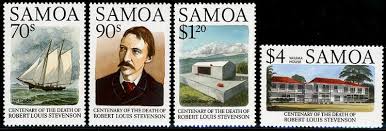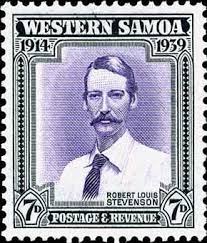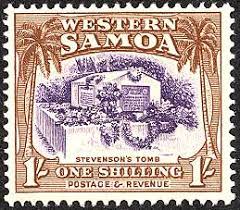Stamp Matters - Robert Louis Stevenson

As a child, I was an avid reader of the boy’s stories of Robert Louis Stevenson and his poetry. Was introduced to them by a biography in the N.S.W. Department of Education School Magazine and I devoured the adventures of Jim Hawkins and David Balfour avidly. I was also taken by his poetry and like so many others, can still recall a lot of ‘My Shadow’ seventy years on.

Robert Louis Stevenson was born in Edinburgh in 1850, the son and only child of a noted lighthouse engineer. His childhood was plagued by illness and his bronchial condition, common in Edinburgh at that time, saw him gain a rather disjointed education as he bounced between formal schools and private tutoring as his health demanded.
His favourite pastime during his bouts of illness was to write stories, an interest fostered by his father who had harboured similar leanings as a child. He went on to study Engineering at the University of Edinburgh but had little interest in his studies, preferring the seeking out of like-minded bohemian students to the rigours of mathematics. He declared his decision to become a writer, much to the despair of his parents.
He travelled widely throughout Europe in his youth and early adulthood, using his travels as inspiration for his writing. He gradually gained a reputation as a romantic novelist and a travel writer. In 1876 visited Belgium on a canoeing holiday. It was here he met his future wife Fanny, a magazine writer of some note in the U.S.A.

Fanny had married young. Her husband, a veteran of the American Civil War, was often unfaithful and Fanny and her children finally separated from him in 1878. After her holiday in Belgium she returned to America and Stevenson followed her. They married in 1880. They shuttled between England and America for a few years and finally settled in Bournemouth in Dorset where he wrote the bulk of his recognised works.
In 1888, the Stevensons chartered a yacht and set off on a voyage of the Pacific. They stayed over in many places including Hawaii, New Zealand, Sydney and the Gilbert Islands over a period of three years and finally found his home in Apia in Western Samoa.

After staying in Apia for several months and making many friends amongst the native peoples of the island, the family settled on a property at Vailima. While his wife managed the finances and the estate, Stevenson immersed himself in the culture of his new home. He took on the name ‘Tusitala’, the Teller of Tales, and became an advocate for the people in the struggle between nations for control of the island.

In 1894 he suffered cerebral haemmorhage and died. The natives carried his body to the nearby Mount Vaea where he was buried amidst great grief. On his tombstone was inscribed his poem “Requiem”. “Under the wide and starry sky ”.
His stories live on today, bringing joy to boys and girls and adults alike.


